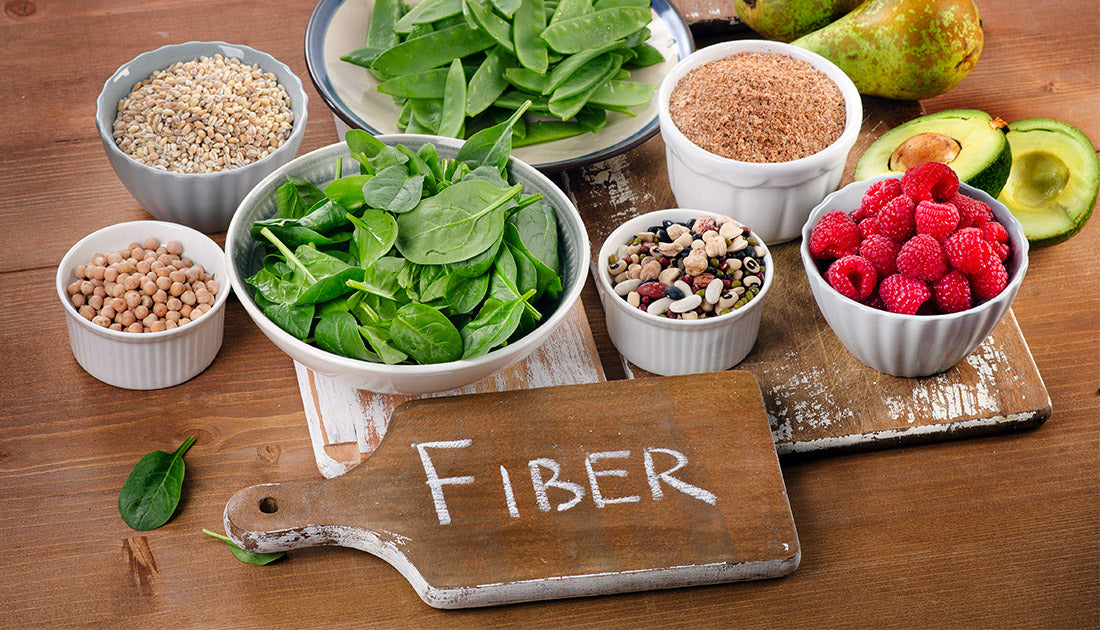Fiber is a type of carbohydrate that our bodies cannot digest that typically comes from plants' cell walls. It functions similarly to our bones in that it helps the plant maintain its shape and structural integrity.
There are two main types of dietary fiber: soluble fiber and insoluble fiber.
Soluble Fiber
Soluble fiber (as the name implies) dissolves in the water, forming a viscous, gel-like substance.
The bacteria in your gut (microbiome) ferment soluble fiber into important byproducts, including short-chain fatty acids like butyrate.
Soluble fiber is also called prebiotic fiber because it acts as a type of food for your gut bacteria.
Foods high in soluble fiber include:
- Fruits
- Vegetables
- Grains
- Legumes
Beyond its gut health benefits, eating soluble fiber also slows gastric emptying and increases your feeling of fullness[1], which can help prevent overeating and support weight loss.
Insoluble Fiber
Insoluble fiber does not dissolve in water and passes through your digestive system relatively unchanged, absorbing water as it goes. Eventually, insoluble fiber adds bulk to your stool and eases bowel movements.
Insoluble fiber is found in:
- Nuts
- Seeds
- Legumes
- Some vegetables
- Some fruits
- Grains
Despite the benefits of fiber in the diet, many individuals struggle to consume enough dietary fiber each day.[2]
Individuals who struggle to consume enough dietary fiber from whole foods may benefit from using a fiber supplement, such as SteelFit® Sunfiber®.
Sunfiber® is a research-backed prebiotic fiber that increases good bacteria, Bifidobacteria and Lactobacillus, which promotes a healthy gut microbiota.
Sunfiber® is also fermented by bacteria in the gut, producing short-chain fatty acids such as butyrate, which provide energy for the digestive tract. Best of all, Sunfiber® mixes easily into water (or any other liquid) and won’t affect taste or texture.
As a fiber, Sunfiber® reduces post-meal blood sugar spikes by decreasing the glycemic index of foods and slowing digestion, promoting feelings of fullness.
Does Fiber Count as A Carb?
Counting calories or macros is an effective method for achieving your fitness and physique goals, be it muscle gain, fat loss, or body recomposition.
There are many apps freely available to help you track your nutrition intake from one day to the next, but there is some confusion as to how to account for the fiber contents of foods.
Does fiber count as a carb?
Does it not (since our bodies technically can’t digest it)?
What’s the deal?!
Well, when it comes to counting carbs, you can either count total carbs or net carbs.
Total carbs is pretty self-explanatory. It is the total number of carbohydrates contained in a food.
Net carbs are the number of carbs left over after subtracting out the fiber content and sugar alcohols (if included in the product).
In other words, net carbs indicate the number of grams of carbohydrates that affect your blood sugar levels, which some would contend is the only carbs you need to count.
So, which should you track -- total carbs or net carbs?
Honestly, it doesn't matter so long as you're consistent with how you track your intake. You can get results both ways if your goals are fat loss or muscle growth. If you're following a ketogenic diet, though, it may be more helpful to count net carbs (which we'll explain more in a bit).
First, let’s discuss...
What Carbs are High in Fiber?
|
Food |
Serving Size |
Grams of Fiber |
|
FRUITS |
||
|
Raspberries |
1 cup |
8.0 |
|
Pear |
1 medium |
5.5 |
|
Apple, with skin |
1 medium |
4.5 |
|
Banana |
1 medium |
3.0 |
|
Orange |
1 medium |
3.0 |
|
Strawberries |
1 cup |
3.0 |
|
VEGETABLES |
||
|
Broccoli, boiled |
1 cup chopped |
5.0 |
|
Brussels sprouts, boiled |
1 cup |
4.0 |
|
Potato, with skin, baked |
1 medium |
4.0 |
|
Cauliflower, raw |
1 cup chopped |
2.0 |
|
Carrot, raw |
1 medium |
1.5 |
|
NUTS, SEEDS, & LEGUMES |
||
|
Lentils, boiled |
1 cup |
15.5 |
|
Black beans, boiled |
1 cup |
15.0 |
|
Chia seeds |
1 ounce |
10.0 |
|
Almonds |
1 ounce (23 nuts) |
3.5 |
|
Pistachios |
1 ounce (49 nuts) |
3.0 |
|
GRAINS |
||
|
Spaghetti, whole-wheat, cooked |
1 cup |
6.0 |
|
Barley, pearled, cooked |
1 cup |
6.0 |
|
Bran flakes |
3/4 cup |
5.5 |
|
Quinoa, cooked |
1 cup |
5.0 |
|
Oatmeal, instant, cooked |
1 cup |
5.0 |
|
Popcorn, air-popped |
3 cups |
3.5 |
|
Brown rice, cooked |
1 cup |
3.5 |
|
Bread, whole-wheat |
1 slice |
2.0 |
Can You Eat Fiber on Keto?
One of the common criticisms of the keto diet is that it is low in dietary fiber.
This stems from the fact that to get into ketosis; you have to limit the number of carbohydrates you eat each day as consuming too many raises insulin levels and blood sugar, which prevents your body from burning stored body fat and subsequently generating ketones.
As such, keto diets are high fat, moderate protein, and low carbohydrate.
Typically, individuals have to consume less than 50 grams of net carbs per day (total carbs minus fiber and sugar alcohols) to achieve and maintain ketosis.
It should be mentioned that the number of carbs you can eat per day can be slightly higher or lower based on your age, weight, sex, genetics, and level of physical activity (very active individuals can eat higher amounts of carbs, particularly around training, and remain in nutritional ketosis).
While it is true that most low-carb ketogenic foods do not contain as much fiber as fruits, starchy vegetables, seeds, nuts, grains, or legumes, there are still plenty of keto-approved foods that can supply fiber in your diet, such as:
- Dark leafy greens (spinach, kale, collard greens)
- Broccoli
- Cauliflower
- Romaine lettuce
- Nuts (pecans, almonds, walnuts, etc.)
- Seeds (flax, chia, pumpkin, etc.)
- Avocado
- Berries (in limited quantities)
How Much Fiber Should I Eat Per Day?
The Academy of Nutrition and Dietetics recommends consuming about 14 grams of fiber per 1,000 calories eaten daily.[3]
This equates to approximately 25 grams of fiber for women and 38 grams for men.[4]
Unfortunately, surveys indicate that only about 5% of the population consumes enough fiber each day.[4]
Tips for Increasing Fiber Intake
- Eat whole fruits and vegetables instead of drinking juices or smoothies that only use fruit.
- Include a portion of fruit or serving of vegetables with each meal (i.e., an apple with breakfast, spinach salad for lunch, grilled asparagus for dinner, and berries with Greek Yogurt for dessert)
- Replace white bread and pasta with whole-grain options like whole-wheat bread, whole-wheat pasta, quinoa, farro, etc.
- Replace cold, sugary breakfast cereal while whole grain options (i.e., oatmeal), or flip the script and go savory (egg and veggie scramble).
- Prep raw vegetables ahead of time and have them ready to snack on instead of cookies, chips, crackers, or candy bars.
- Add beans or legumes to chili, soups, salads, or stews.
- Use a daily fiber supplement, such as SteelFit® Sunfiber®, mixed into oatmeal, smoothies, soups, post-workout, or pre-bed protein shakes.
Takeaway
Fiber is an important part of a healthy diet and is known to support overall health and wellness, as it provides a source of energy for the good bacteria in our gut.
Moreover, fiber also forms short-chain fatty acids, which nourish the cells lining your colon, and it may reduce your appetite, lower cholesterol levels and attenuate the rise in blood sugar after high-carb meals.
It’s recommended to get your fiber consumption from natural food sources. But as we all know, it can be a challenge to eat enough fiber each day (even if you are typically a very clean eater).
Fortunately, there are high-quality supplements to help you get your recommended daily fiber.
SteelFit® Sunfiber® is an all-natural fiber supplement that delivers 6 grams of soluble fiber per serving without causing excess gas or bloat typically associated with other fibers.
References
- Clark MJ, Slavin JL. The effect of fiber on satiety and food intake: a systematic review. J Am Coll Nutr. 2013;32(3):200-11. doi: 10.1080/07315724.2013.791194. PMID: 23885994.
- Hoy, M., & Goldman, J. (2014). Fiber intake of the U.S. population: What We Eat in America. Nhanes 2009-2010, 12, 1–6.
- Recommended daily intake. Fiber Facts – For Consumers, About Dietary Fiber. https://www.fiberfacts.org/consumer-recommended-daily-intake/
- Quagliani D, Felt-Gunderson P. Closing America's Fiber Intake Gap: Communication Strategies From a Food and Fiber Summit. Am J Lifestyle Med. 2016;11(1):80-85. Published 2016 Jul 7. doi:10.1177/1559827615588079

